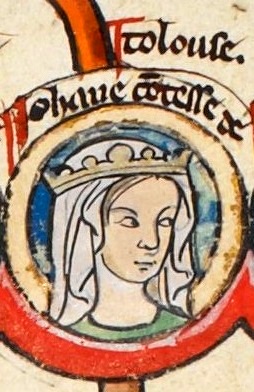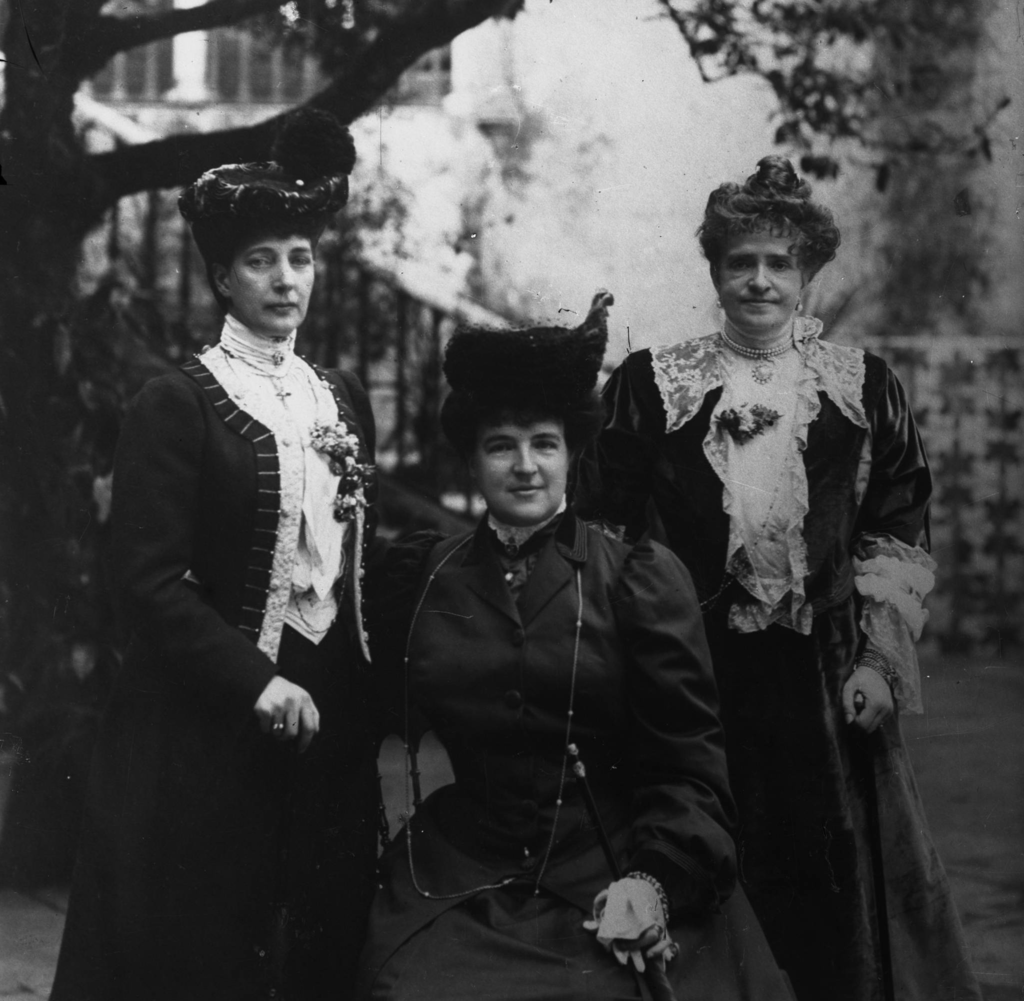by Susan Flantzer © Unofficial Royalty 2013

King Richard I of England and his sister Joan greeting King Philip Augustus II of France, Credit – Wikipedia
Voyages on storm-tossed ships on the Mediterranean Sea. Being held captive and penniless by your husband’s successor and then being gallantly rescued by your brother. Being marooned and nearly captured after a strong storm and again being gallantly rescued by your brother. Accompanying your brother and his new wife on the Crusades in the Holy Land. Being offered by your gallant brother as a bride to the brother of the man who led the Islamic opposition in the Crusade and being left to deal with a rebellion while you are pregnant. It sounds like an author’s imagination for a new book, but in reality, it is the life of Joan of England, the youngest daughter of King Henry II of England and Eleanor of Aquitaine. However, Joan does have prominent roles in Sharon Penman‘s wonderful novels Devil’s Brood and Lionheart where she is referred to as Joanna.
Joan, sometimes called Joanna, was born at Château d’Angers in the County of Anjou, now in France in October 1165. She was the third and youngest daughter and the seventh of eight children of King Henry II of England, who was also Count of Anjou, Count of Maine, Duke of Normandy, Duke of Aquitaine, and Count of Nantes – all territories in France – and Eleanor of Aquitaine who was Duchess of Aquitaine and Countess of Poitou in her own right. Joan grew up in her mother’s court at the Palace of Poitiers, the seat of the Counts of Poitou and Dukes of Aquitaine, and also at Winchester Castle and/or Sarum Castle in England during part of the time her father kept her mother imprisoned because of her participation in the Revolt of 1173-1174.
Joan had seven siblings:
- William IX, Count of Poitiers (1153 – 1156), died in childhood
- Henry the Young King (1155 – 1183), married Marguerite of France, no children
- Matilda of England, Duchess of Saxony and Bavaria (1156 – 1189), married Heinrich the Lion, Duke of Saxony and Bavaria, had five children, including Otto IV, Holy Roman Emperor
- King Richard I of England (1157 – 1199), married Berengaria of Navarre, no children
- Geoffrey II, Duke of Brittany (1158 – 1186), married Constance, Duchess of Brittany, had three children
- Eleanor of England, Queen of Castile (1162 – 1214), married King Alfonso VIII of Castile, had twelve children including King Enrique I of Castile; Berengaria, Queen Regnant of Castile and Queen of León; Urraca, Queen of Portugal; Blanche, Queen of France, and Eleanor, Queen of Aragon
- King John of England (1166 – 1216), married 1) Isabella, 3rd Countess of Gloucester, marriage annulled, no children (2) Isabella, Countess of Angoulême; had five children, including King Henry III of England; Joan of England, Queen of Scots, and Isabella of England, Holy Roman Empress

13th-century depiction of Henry and his legitimate children: (l to r) William, Young Henry, Richard, Matilda, Geoffrey, Eleanor, Joan, and John; Credit – Wikipedia
Joan spent time at Fontevrault Abbey near Chinon in Anjou, now in France, learning English, Norman French, rudimentary Latin, and skills necessary for running an aristocratic household. Joan’s family was a great benefactor of Fontevrault Abbey and it was common for aristocratic girls to receive an education at abbeys. Fontevrault Abbey became the burial place for Joan’s parents, her brother King Richard I, Isabella of Angoulême, the second wife of her brother King John, and Joan herself.

Fontevrault Abbey, Credit – Wikipedia
At this time it was common for royal and aristocratic girls to marry young. Joan’s eldest sister Matilda married Henry the Lion, Duke of Saxony and Bavaria when she was 12 years old. The next sister Eleanor married King Alfonso VIII of Castile when she was 14 years old. Therefore, it was not unusual when King William II of Sicily sent ambassadors to England in 1176 when Joan was 11 years old to open marriage negotiations. Genetically, William was not Sicilian, but rather Norman. He was a member of the Hauteville family which rose to prominence in Europe, Asia, and Africa through its conquests in the Mediterranean, especially Southern Italy and Sicily. Joan and William, who was ten years older than Joan, were betrothed on May 20, 1176.
On August 27, 1176, Joan left England for Sicily accompanied by John of Oxford who later became Bishop of Norwich and her uncle Hamelin de Warenne, Earl of Surrey, an illegitimate son of King Henry II’s father Geoffrey of Anjou. Typical for royal travel of the period, Joan was also accompanied by ladies-in-waiting, knights, clergy, and everything from cooks and seamstresses to grooms and blacksmiths. Joan’s eldest brother Henry the Young King accompanied her across the English Channel and then to Poitiers. In Poitiers, Joan was met by her brother Richard, who escorted her through the Duchy of Aquitaine across the County of Toulouse to Saint Gilles, a French port on the Mediterranean Sea. In Saint Gilles, Alfano of Camerota the Archbishop of Capua and Richard Palmer the Bishop of Syracuse greeted Joan on behalf of King William of Sicily. The travel across the Mediterranean Sea was dangerous and long and Joan did not reach Sicily until the end of January 1177.
On February 13, 1177, Joan married King William II of Sicily and was crowned Queen of Sicily at Palermo Cathedral. The Sicilian court was very different than the courts Joan was used to. Much of Sicily was Muslim and this influence was obvious in the Sicilian culture where there were harems, and clothing and food much more exotic than what Joan had ever seen. According to chronicler Robert of Torigni, Joan gave birth to a son Bohemund in 1182, but the child died in infancy. She may also have had miscarriages during this period. Her father, King Henry II of England, died in July 1189. In November of the same year, Joan was widowed when 36-year-old William died following an illness.

Deathbed of King William II of Sicily, Credit – Wikipedia
Following King William’s death, there was a revolt in which Tancred, Count of Lecce, an illegitimate member of the Hauteville family, seized control of Sicily and was crowned King. Joan was imprisoned by Tancred who took control of her inheritance. In 1190, King Richard I of England, Joan’s brother, arrived in Sicily on his way to the Third Crusade in the Holy Lands. Richard demanded that his sister be released and given her inheritance. Joan was freed on September 28, 1190, but without the inheritance. Richard attacked Messina in Sicily, capturing it on October 4, 1190. After looting and burning Messina, Richard established his base there and remained in Messina until Tancred finally agreed to sign a treaty on March 4, 1191. One of the treaty’s provisions was to compensate Joan for her taken inheritance.
In the same month the treaty was signed, Joan and Richard’s mother Eleanor of Aquitaine arrived in Messina with Richard’s bride-to-be Berengaria of Navarre. Berengaria was left in Joan’s care and Eleanor returned to England. Richard postponed his wedding and set off for the Holy Land along with Joan and Berengaria who were on a separate ship. Two days after setting sail, Richard’s fleet was hit by a strong storm. Several ships were lost and others were way off course. Richard landed safely in Crete, but the ship Joan and Berengaria were on was marooned near Cyprus. Joan and Berengaria were about to be captured by the ruler of Cyprus when Richard’s ships appeared to rescue them. On May 12, 1191, King Richard I of England married Berengaria of Navarre at the Chapel of St George in Limassol, Cyprus, and then his fleet, along with Joan and Berengaria, traveled to the Holy Land.

King Richard I of England and Queen Berengaria, Credit – Wikipedia
Joan and Berengaria accompanied Richard throughout the Crusade. At one point, Richard tried to use his sister Joan in a political scheme. He suggested marrying her to Al-Adil, the brother of Saladin who led the Islamic opposition against the European Crusaders, and making them joint rulers of Jerusalem. This plan fell apart when Joan refused to marry a Muslim and Al-Adil refused to marry a Christian.
When Joan and Berengaria returned from the Holy Land on a different ship than Richard, they landed at Naples and then proceeded to Rome where they had to stay for a year until the Pope gave them safe conduct to travel to Marseilles. It was at Marseilles that Joan fell in love with Raymond VI, Count of Toulouse. Joan and Raymond married in October of 1196 in Rouen, Normandy. Joan gave birth to her husband’s successor Raymond VII and a daughter Mary (or Wilhelmina) born in 1198, who married Berald of Elbine, Prince of Orange.

Joan of England, Credit – Wikipedia
In 1199, while Joan was pregnant with her third child, she was left to deal with a rebellion. Fearing her safety, she traveled to northern France, hoping for the protection of her brother King Richard, but he had died on April 6, 1199. Joan then fled to her mother’s court at Rouen in Normandy. Aged 33, Joan died at Fontevrault Abbey on September 4, 1199, shortly after giving birth to a son who lived just long enough to be baptized Richard. Joan was veiled as a nun on her deathbed and was buried at Fontevrault Abbey. In 1249, her son Raymond VII of Toulouse was buried next to her. Unfortunately, both their tombs were destroyed during the French Revolution.
This article is the intellectual property of Unofficial Royalty and is NOT TO BE COPIED, EDITED, OR POSTED IN ANY FORM ON ANOTHER WEBSITE under any circumstances. It is permissible to use a link that directs to Unofficial Royalty.
















